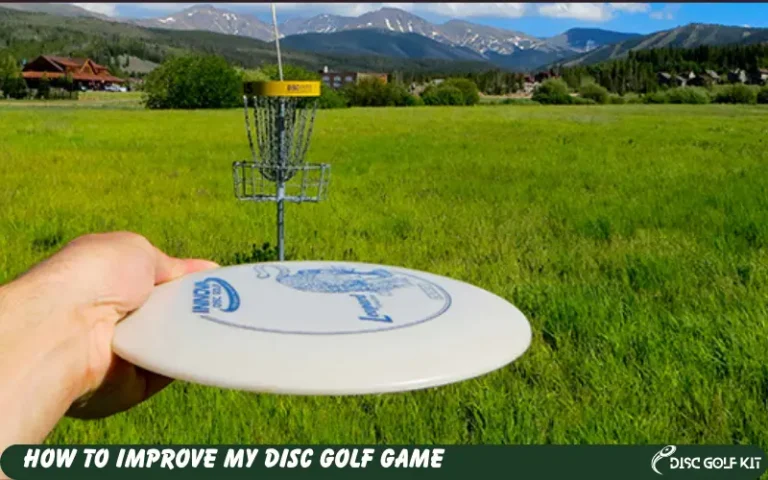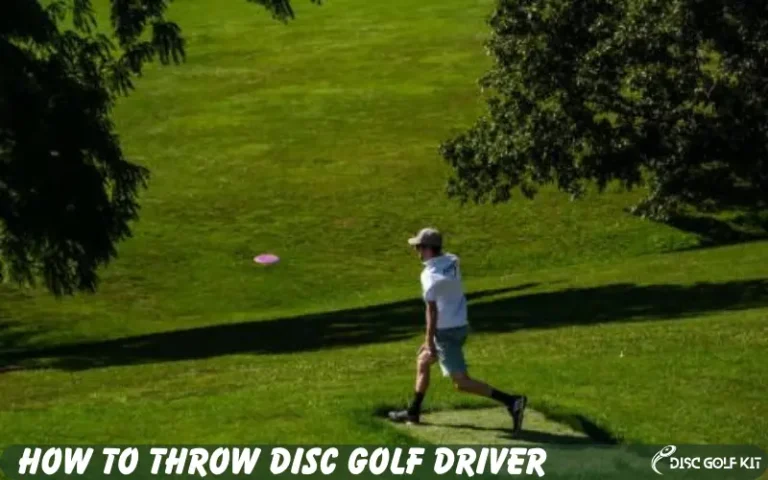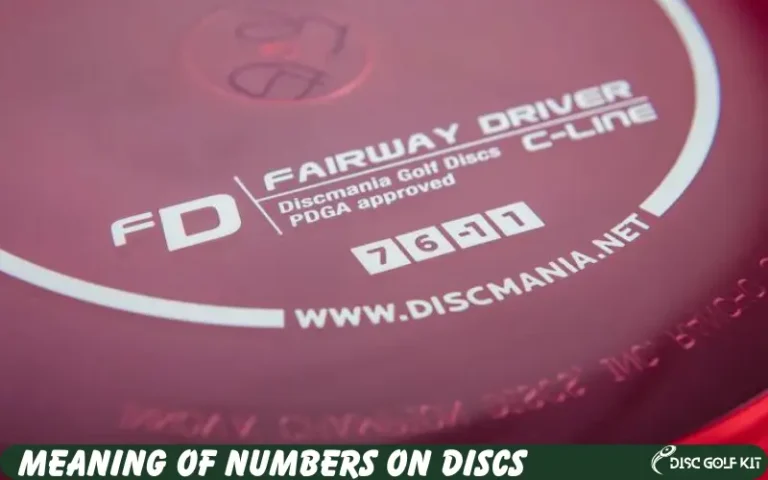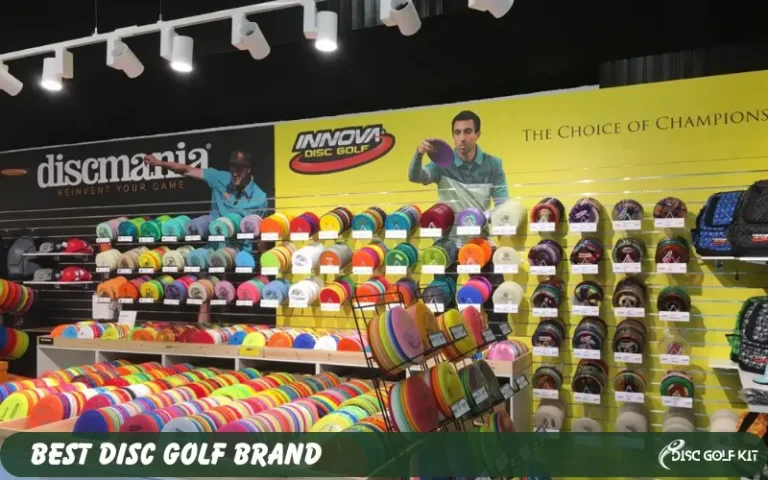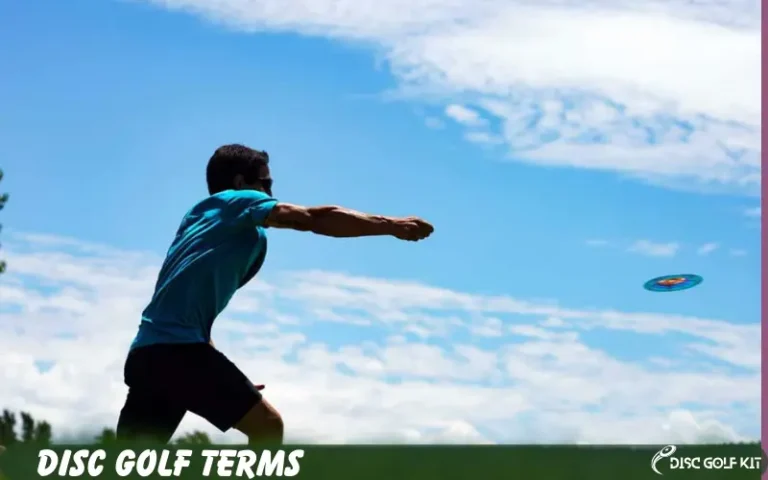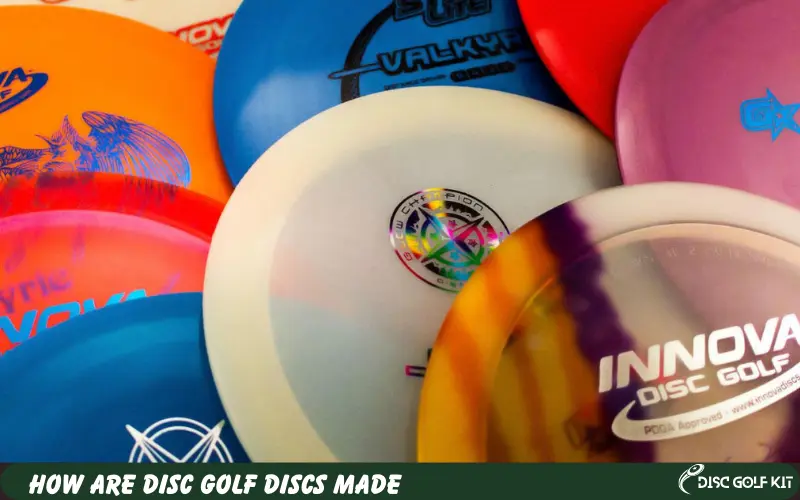
Navigating the world of disc golf can be as perplexing as exciting, especially when choosing the correct disc. Either way, you’ve likely asked yourself, “How are disc golf discs made?” Good news! You’ve come to the right place. Disc golf discs are primarily manufactured through injection and compression moulding. Many companies also use Computer-Aided Design (CAD) to ensure precision and quality. Plastics like DX plastic, Champion plastic, and Star plastic are commonly used. Each material has benefits and drawbacks, affecting durability, grip, and flight patterns.
The importance of understanding the creation of disc golf discs can’t be overstated. It’s not just about satisfying your curiosity; it also has practical implications for your game. Imagine having the knowledge to choose the perfect disc for every scenario, every type of shot, and every course layout. That’s robust information, and it’s information that can elevate your game from casual to competitive.
The goal of this article is straightforward yet comprehensive: to guide you through the fascinating journey of how are Disc Golf Discs made or comes into existence. From the raw materials to the moulding processes, from quality control to its final form, we’ll explore every nuance of this intriguing topic. By the end, you won’t just be holding a piece of plastic but a marvel of design and engineering tailored for flight. Ready to embark on this journey? Let’s dive in.
History of How Are Disc Golf Discs Made
The history of how are Disc Golf Discs made is intertwined with the evolution of the sport itself. Disc golf, often referred to as Frisbee golf, is a popular recreational and competitive sport involving throwing specialized discs into a series of target baskets in as few throws as possible. The development of disc golf discs has been a fascinating journey, mirroring the growth and maturation of the sport.
The roots of disc golf can be traced back to the 1960s when individuals began using regular Frisbees to aim at targets such as trees, trash cans, or other objects. The first recorded game of disc golf took place in 1961 when a group of California teenagers began playing “object golf” in their school’s parking lot.
The transformation in the design and manufacturing of disc golf discs over the years is revolutionary. Early discs were rudimentary and needed more specialization. But with the advent of new materials and manufacturing technologies, they’ve become highly specialized tools engineered for specific tasks. These discs have come a long way from the initial stage of injection moulding to the final touches added for aesthetic appeal and improved aerodynamics.
It’s not just about different types of discs; it’s about innovation. New materials are continually being experimented with, aerodynamic designs are optimized using computer software, and new moulding techniques are developed to create discs that are ever more precise, durable, and suited for every player.

How Are Disc Golf Discs Made
The manufacturing process of golf discs, also known as discs or simply discs, involves several steps to create these specialized flying discs designed for disc golf. Here’s an overview of the typical manufacturing process:
Material Selection
The first step in manufacturing golf discs is the selection of materials. Most modern golf discs are made from various types of plastic, each with its unique properties, such as durability, grip, and weight. Common plastics used include polyethene, polypropylene, and blends of different plastics. Understanding the materials that make up your discs is like knowing the ingredients in a secret recipe—it makes the result much more satisfying. Let’s dig in.
Types of Plastics and Other Materials
First, your gaze lands on a sample labelled “Polypropylene.” This material is commonly used for putters because it’s softer and offers excellent grip. It feels pliable and forgiving as you touch it, almost like it’s telling you it can absorb the impact of a tree or the ground with grace.
Next, you see “Polycarbonate,” a more complex, durable plastic generally used for drivers. It feels sturdier, almost invincible, promising long flights and resilience against wear and tear. You can almost hear it whispering promises of those long, satisfying drives down the fairway.
Then there’s “Elastomers,” often used in premium discs for their flexibility and durability. As you hold it, you feel its elasticity and resilience. This material seems to offer the best of both worlds—the grip of polypropylene and the durability of polycarbonate.
Benefits and Drawbacks of Each Material
As you ponder these materials, you realize that each comes with its own pros and cons. Polypropylene offers excellent grip and control but may not be as durable as other materials. It’s perfect for putters but may not withstand the repeated impacts that drivers often endure.
Polycarbonate, on the other hand, is incredibly durable and offers longer flights but may lack the grip you desire, especially in wet conditions. You start to understand that these materials are best suited for certain discs, and not one material is the ultimate solution for all.
Elastomers bring a balance between grip and durability but often come at a premium price. They’re like the luxury sports cars of disc golf materials—offering excellent performance but requiring an investment.
These aren’t just chunks of plastic; they’re carefully selected materials designed to optimize your game in various ways. You also realize that knowing the materials can guide you in choosing the perfect disc for your skill level, playing conditions, and personal preferences.
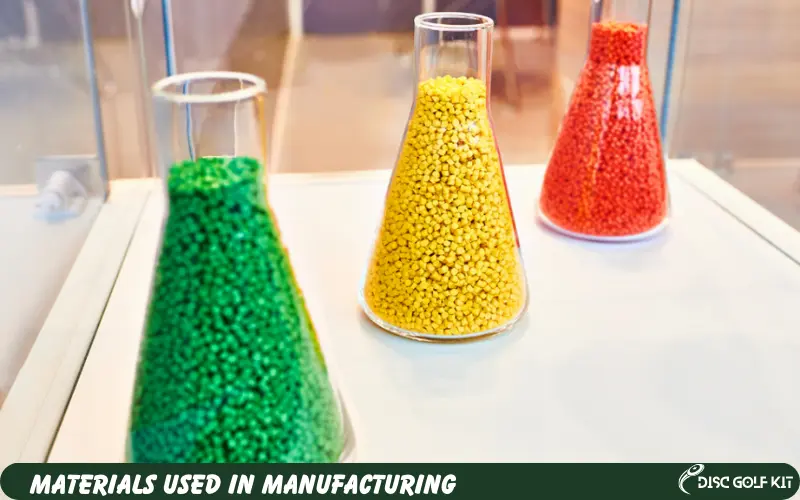
The Manufacturing Process
There are three significant steps in the manufacturing process: Injection Molding, Compression Molding, and Computer-Aided Design (CAD).
Injection Molding
As you approach the injection moulding machine, you hear the mechanical sounds of whirring and clanking and feel the warmth radiating from the equipment. A worker places a plastic pellet into the machine, and it melts into a viscous liquid within moments. The machine then injects this liquid into a disc-shaped mould under high pressure.
As you watch the molten plastic fill the mould, you can almost feel the tension as it takes the shape of a disc golf disc. After a few minutes of cooling, the mould opens to reveal a newly minted disc, still warm to the touch. Injection moulding is mainly used for creating discs with intricate designs and consistent properties. It’s like witnessing the birth of a star, hot and vibrant, ready to take on the universe.
Compression Molding
Next, you wander over to the compression moulding section. Here, sheets of plastic are placed between heated metal plates. You observe as the leaves come together, squeezing the plastic into a disc shape. The pressure is immense, and you can almost sense the plastic’s struggle before it finally succumbs and assumes its new identity. Compression moulding allows for a different range of textures and finishes, and it’s generally a slower process than injection moulding. If injection moulding felt like the birth of a star, compression moulding felt like the slow, deliberate formation of a mountain—both magnificent but in entirely different ways.
Computer-Aided Design (CAD)
Your final stop is a quieter room with engineers staring intently at computer screens. This is where Computer-Aided Design (CAD) takes place. The engineers use advanced software to design a disc golf disc’s aerodynamics, weight distribution, and other vital features. As you look over their shoulder, you see a 3D model of a disc rotating on the screen.
It’s almost like watching a digital sculptor at work, crafting every curve and edge to perfection. The CAD process ensures that the disc’s design is optimized for specific flight characteristics and forms the blueprint that guides the moulding processes you’ve just witnessed. You feel like you’re peering into the creator’s mind, seeing the initial vision leading to the physical objects you hold dear.
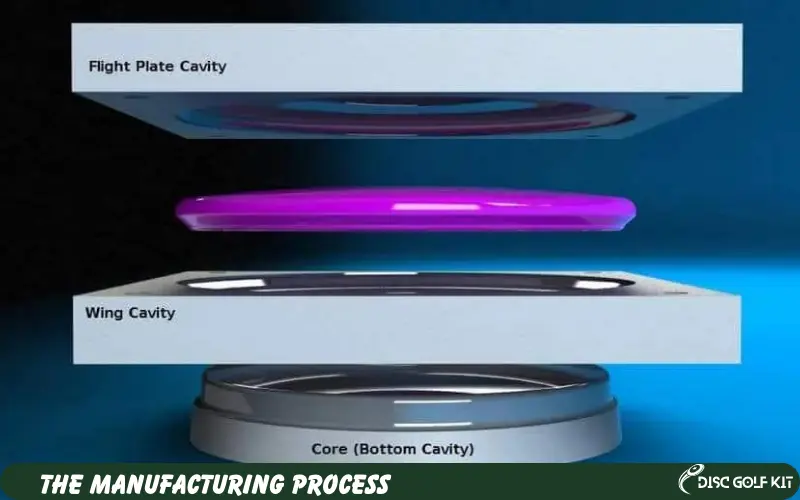
Quality Control
It’s like a final exam hall where each disc proves its worthiness before heading out into the world.
Tests and Checks During the Manufacturing Process
First, pick up a disc and place it on a balancing machine. The disc spins, and you can almost feel the tension in the room. The objective is to ensure the weight is evenly distributed so the disc will fly as designed. You watch as the worker nods approvingly; this disc has passed its first test.
The next step is where discs are lined up for flight testing. They’re launched one after another in a controlled environment, mimicking the conditions they’ll face in a real game. As each disc sails through the air, its flight path is analyzed to ensure it aligns with its design specs. It feels like watching an athlete sprinting down the track, each disc giving its all to prove it’s ready for game day.
How Manufacturers Ensure Uniformity and Quality
In the last step, statistical analysis takes place to ensure uniformity in the production process. If a disc’s measurements are off, even by a fraction, it’s returned for rework or discarded. This rigorous process ensures that every disc you purchase meets a set quality standard. It’s like having a personal trainer who won’t let you settle for anything less than your best performance.
Aside from these tests, there are checks for surface imperfections, colour consistency, and even the print quality of the labels. Every element is scrutinized, every detail attended to. Imagine the satisfaction of the artisans as they examine each masterpiece, ensuring it meets their exacting standards before it leaves the workshop.
Environmental Consideration
Environmental considerations in the how are Disc Golf Discs made have become increasingly important as the awareness of sustainability and environmental impact has grown. Disc manufacturers and the disc golf community are taking steps to minimize the environmental footprint of disc production. Here are some key environmental considerations:
- Material Selection:
- Recycled Plastics: Some disc manufacturers have started using recycled plastics in their disc production. Recycled plastics can reduce the demand for new plastic production and help divert plastic waste from landfills.
- Biodegradable Materials: Research and development efforts are ongoing to create biodegradable plastics for disc manufacturing. These materials break down more easily in natural environments and can reduce the long-term environmental impact of discarded discs.
- Sustainable Sourcing:
- Responsible Sourcing: Manufacturers can prioritize sourcing plastic materials from suppliers that follow sustainable and responsible practices, such as minimizing water and energy use in their production processes.
- Energy Efficiency:
- Efficient Manufacturing Processes: Manufacturers can invest in energy-efficient manufacturing equipment and processes to reduce energy consumption and greenhouse gas emissions during production.
- Waste Reduction:
- Recycling and Reuse: Efforts should be made to recycle or reuse any plastic waste generated during the manufacturing process to minimize the amount of waste sent to landfills.
- Reduced Packaging: Manufacturers can use minimal packaging and opt for eco-friendly packaging materials to reduce waste in the packaging stage.
- Transportation and Distribution:
- Efficient Transportation: Minimizing transportation distances and optimizing logistics can reduce the carbon footprint associated with shipping discs to retailers and consumers.
- End-of-Life Considerations:
- Disc Recycling Programs: Some disc manufacturers and disc golf organizations have initiated disc recycling programs where used or unwanted discs can be collected and recycled into new discs or other plastic products.
- Education and Awareness: Disc golf communities can promote responsible disc disposal practices, such as donating or recycling old discs, to reduce disc waste in landfills.
- Eco-Friendly Initiatives:
- Partnerships with Environmental Organizations: Manufacturers can collaborate with environmental organizations or support ecological initiatives to offset their environmental impact.
- Product Lines: Some companies have introduced specific product lines or limited-edition discs with environmentally-friendly features or materials, raising awareness and supporting sustainability efforts.
- Longevity and Durability:
- Design for Durability: Creating discs that are more durable and less likely to be discarded due to wear and tear can help reduce the overall environmental impact by extending the life of each disc.
- Consumer Awareness:
- Educating Players: Disc golf communities and manufacturers can educate players about the importance of environmental responsibility, proper disc disposal, and the benefits of choosing environmentally-friendly disc options.

Types of Disc Golf Discs
Following are some types of discs. What’s the difference between all these discs, and how do you choose the right one? Let’s break down the classes to give you a tactile, almost firsthand experience of what each one offers.
Putters
It’s typically thicker and has a deeper rim than other discs, giving you that sense of control and stability. Putters are your go-to discs for short-range shots and, of course, putting them into the basket. They’re like the reliable friend you call when you need a listening ear—consistent and dependable. When you release a putter, you can almost feel the air hug its shape as it moves slowly but accurately towards its target.
Mid-Range Discs
Mid-range disc, feel its slightly shallower rim and balanced weight. These discs are your all-rounders, the Swiss Army knives in your disc golf bag. Mid-range discs offer more distance than putters but still maintain a good amount of control. You’ll use them for various shots, and they’ll often save you when you’re in a pinch. As you release a mid-range disc, it feels like sending a well-trained pet on a mission—it knows what it’s supposed to do and usually does it well.
Fairway Drivers
These discs are sleeker and have a more aerodynamic profile. When you grip a fairway driver, you can sense its potential for greater distances. Fairway drivers are perfect for those long, straight shots down the fairway, and you’ll often use them after your initial drive to approach the basket. Throwing a fairway driver feels like stepping on the gas pedal of a sports car—quick, responsive, and designed to cover ground efficiently.
Distance Drivers
These are the thoroughbreds of your disc golf arsenal, engineered for maximum distance. The rims are the thinnest, and the profiles are the most aerodynamic among all discs. Distance drivers are usually the first choice for the opening drive on most holes, and when you unleash one, it’s like shooting an arrow from a bow—fast, far, and exhilarating.
Specialty Discs
Last but not least, let’s remember the speciality discs. These are the curveballs, the tricksters, the highly specialized tools designed for unique situations. Whether it’s a disc that floats on water or one designed for extreme trick shots, speciality discs add excitement and unpredictability to the game. Using one feels like pulling a wild card in a game of poker—unexpected but potentially game-changing.
The Importance of Disc Technology in Gameplay
Disc technology plays a crucial role in the gameplay of disc golf, significantly influencing a player’s performance and overall experience. The importance of disc technology in disc golf can be understood in several key aspects:
- Flight Characteristics: Disc technology, including the disc’s shape, weight distribution, and aerodynamic properties, directly affects its flight characteristics. Different discs are designed to have specific flight paths, such as straight and stable, unstable, or Overstable. Players rely on these characteristics to control their throws’ trajectory, distance, and accuracy. Choosing discs with the correct flight characteristics for specific shots is fundamental to success in disc golf.
- Distance: Disc technology significantly impacts the space a player can achieve. High-speed drivers are designed for maximum length and are often used for long tee shots. The aerodynamic properties of these discs, along with their weight and shape, allow players to achieve impressive distances. The choice of the right driver can mean the difference between reaching the basket in one throw or requiring multiple throws.
- Accuracy and Control: Mid-range and putter discs are designed for accuracy and control. These discs are typically slower and more stable, making them ideal for precision shots. Disc technology influences the stability and glide of these discs, helping players navigate obstacles, approach the basket, and make accurate putts.
- Wind Resistance: Disc technology also accounts for a disc’s ability to handle different wind conditions. Overstable discs are more resistant to wind interference, making them suitable for windy days when maintaining control and stability is essential. Understanding how other discs react to the wind helps players adapt their strategies and select the appropriate discs for the conditions.
- Skill Progression: Disc technology accommodates players of various skill levels. Beginners may start with more forgiving, understandable discs that are easier to control, while advanced players can leverage the unique flight characteristics of high-speed, Overstable discs to shape their shots.
- Innovation and Variety: Disc manufacturers continually innovate, introducing new disc models with unique technology and designs. This innovation adds excitement to the sport, encourages exploration of new disc options, and keeps players engaged and motivated to improve their gameplay.
Conclusion
Wow, what a journey we’ve been on! From unearthing the history of disc golf discs to diving into their manufacturing complexities, we’ve navigated through every facet that makes this game not just a sport but an art form. We’ve explored the various types of discs, dissected the materials used, and even pulled back the curtain on quality control and environmental considerations
Armed with this information, you’re not just playing a game; you’re partaking in a ritual that merges physics, chemistry, engineering, and pure athletic skill. Understanding how disc golf discs are made doesn’t satisfy your curiosity; it enhances every throw, every game, and every win. The insight you’ve gained today provides you with a richer, more fulfilling disc golf experience. You’re not just holding a disc; you’re holding a story of design, craftsmanship, and rigorous quality tests.
Frequently Asked Questions

Written by
Declan Hodgson
Meet Declan Hodgson, your disc golf sherpa at DiscGolfKit.com. Navigating the twists and turns of the sport, I’m here to guide you through the world of discs, gear, and the pursuit of that perfect throw.


